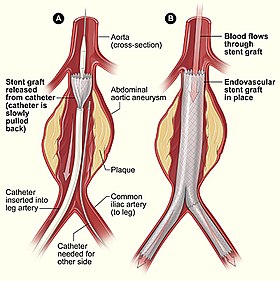Minimally-invasive procedure
| Minimally invasive procedures | |
|---|---|
| Intervention | |

Endovascular aneurysm repair -example of minimally-invasive procedure
|
|
| eMedicine | 938198 |
Minimally invasive procedures (also known as minimally invasive surgeries) have been enabled by the advance of various medical technologies. Surgery by definition is invasive and many operations requiring incisions of some size are referred to as open surgery. Incisions made can sometimes leave large wounds that are painful and take a long time to heal. Minimally invasive surgery refers to surgical techniques that limit the size of incisions needed and so lessens wound healing time, associated pain and risk of infection. An endovascular aneurysm repair as an example of minimally invasive surgery is much less invasive in that it involves much smaller incisions, than the corresponding open surgery procedure of open aortic surgery. This minimally invasive surgery became the most common method of repairing abdominal aortic aneurysms in 2003 in the United States.
The front-runners of minimally invasive procedures were interventional radiologists. By the use of imaging techniques, interventional instruments could be directed throughout the body by the radiologists by way of catheters instead of large incisions needed in traditional surgery. So that many conditions once requiring surgery can now be treated non-surgically.
Diagnostic techniques that do not involve the puncturing of the skin or incision, or the introduction into the body of foreign objects or materials are known as non-invasive procedures. There are also several treatment procedures that are classed as non-invasive. A major example of a non-invasive alternative treatment to surgery is radiation therapy also called radiotherapy.
Minimally invasive procedures were pioneered by interventional radiologists who had first introduced angioplasty and the catheter-delivered stent. Many other minimally invasive procedures have followed where images of all parts of the body can be obtained and used to direct interventional instruments by way of catheters (needles and fine tubes). So that many conditions once requiring open surgery can now be treated non-surgically. A minimally invasive procedure typically involves the use of arthroscopic (for joints and the spine) or laparoscopic devices and remote-control manipulation of instruments with indirect observation of the surgical field through an endoscope or large scale display panel, and is carried out through the skin or through a body cavity or anatomical opening. Interventional radiology now offers many techniques that avoid the need for surgery.
...
Wikipedia
